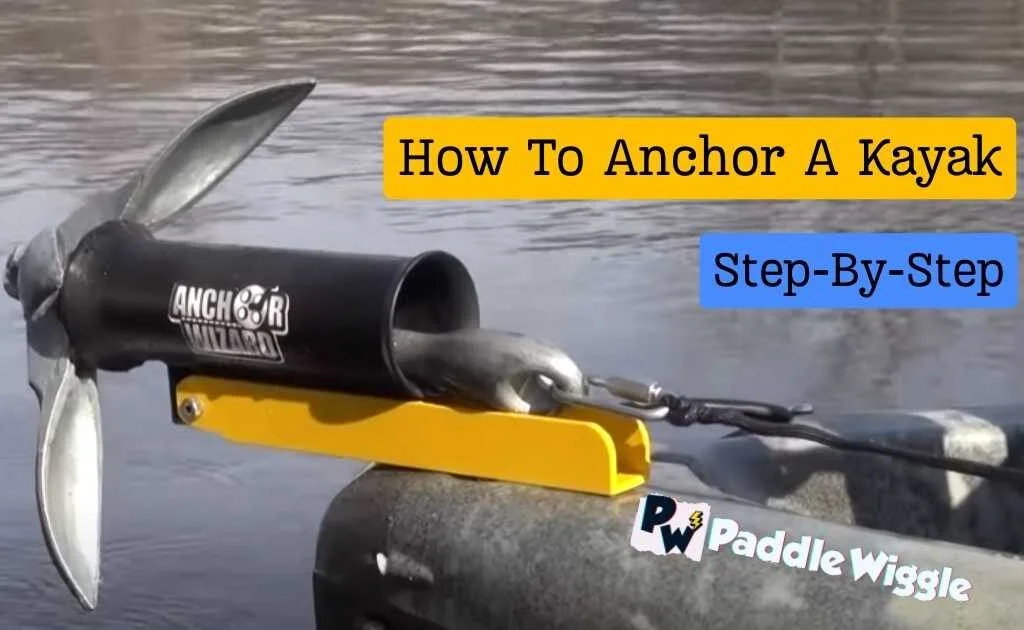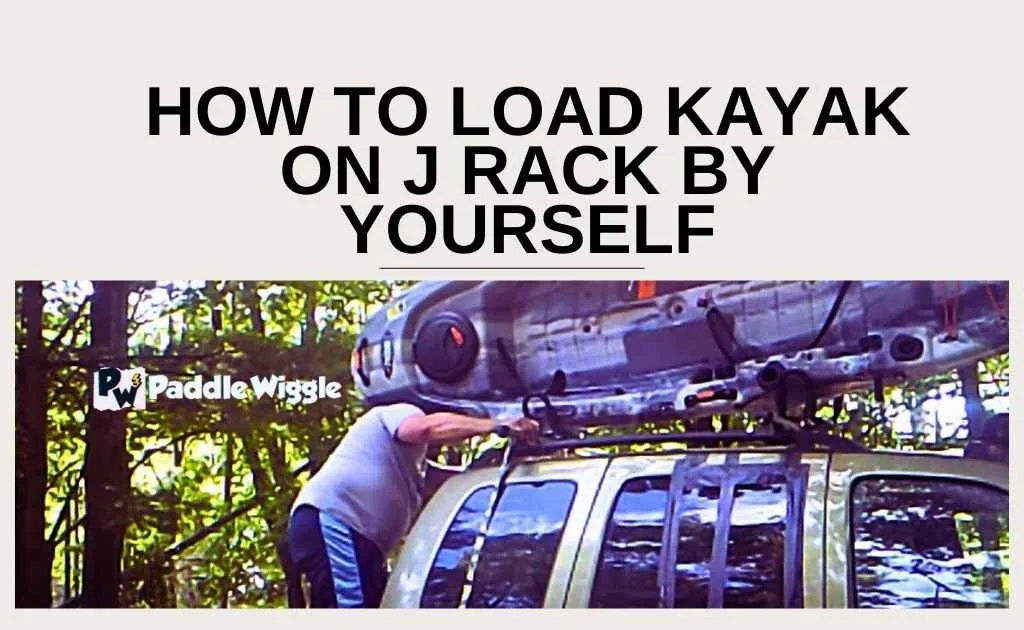You’ve just had an exhilarating day on the water, conquering waves and soaking in the sun’s warmth from your kayak. But as the day winds down and reality settles in, you’re faced with a familiar hassle – where and how to store a kayak?
Finding the perfect spot and determining the best method for your indoor is a real struggle, especially when you have limited space. And it’s a crucial step to ensure the longevity of your kayak and prevent any damage.
It’s a challenge that every kayak enthusiast knows all too well.
That’s why we came up with this handy guide!
This article explores three effective indoor kayak storage solutions to protect your investment. Emphasizing both space-saving and budget-friendliness, we’ve listed them with our practical tips to ensure your kayak remains in top shape even during the off-season.
Let’s dive in.
Contents


The 3 Best Ways To Store A Kayak Indoors
Storing your kayak indoors is a smart way to ensure its safety and extend its lifespan. When it comes to finding the best methods, there are three proven approaches that are effective and help you save space: hanging, using a rack, or standing upright.
Let’s dive deeper!
Hanging Method: Maximizing Space And Easy Access
When it comes to storing your kayak in an apartment, the hanging method is like a superhero for space-saving. Imagine using special mounts on the wall or ceiling that are designed just for kayaks.
These mounts are strong and can hold your kayak up like a hammock for your boat. With a little care and the right setup, your kayak will hang out in style, waiting for your next water adventure.
Suitable For
The hanging method can be a great choice if you have limited floor space and available wall or ceiling space.
Using Wall Or Ceiling Mounts
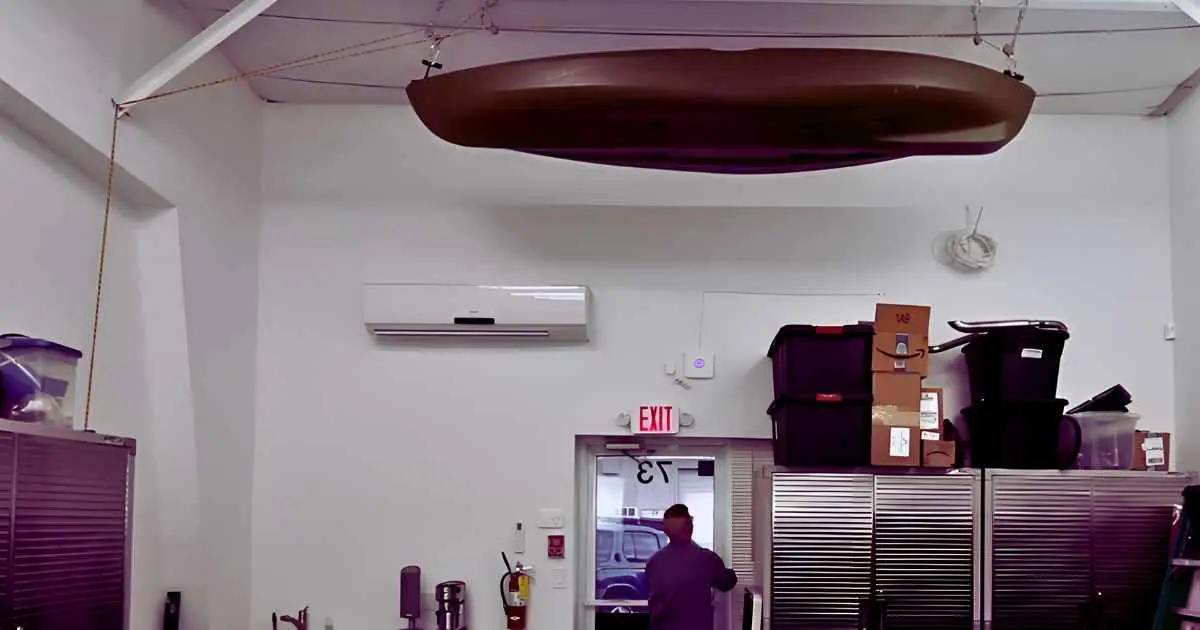

You know those brackets that hold up shelves? Well, imagine similar brackets, but super strong, that you attach to the wall or ceiling. These brackets are made just for kayaks.
Depending on the space you have, you can choose whether to put them on the wall or hang them from the ceiling. It’s like giving your kayak a cozy spot off the ground.
Why Hanging Storage Is Cool: Saving Space And Being Handy
The best part of the hanging method? It saves a lot of space. Lifting your kayak off the floor creates more room for other things. This is super handy, especially if you have a small storage area.
And guess what? When you want to use your kayak, it’s ready to go—no more shuffling stuff around or searching for your boat in a sea of stuff. Just unhook your kayak from the hanging spot, and you’re good to go on your next water adventure.
Making Sure Your Kayak Is Safe And Sound: Tips For Success
To make sure your kayak stays safe when it’s hanging, keep these things in mind:
Find a Strong Spot: Pick a sturdy place on the wall or ceiling that can handle the weight of your kayak. Make sure there’s nothing fragile nearby that could get hurt if the kayak moves.
Use Good Straps: Get special straps or slings made for hanging kayaks. These are like strong belts that will hold your kayak safely.
Keep it Balanced: When you hang your kayak, make sure it hangs evenly. This way, it won’t get twisted or bent.
DIY Fun: If you like making things yourself, you can create a hanging system with tough ropes and hooks. Just make sure you know how to tie strong knots and that everything can hold the weight.
Rack Storage Method: Stability And Organization
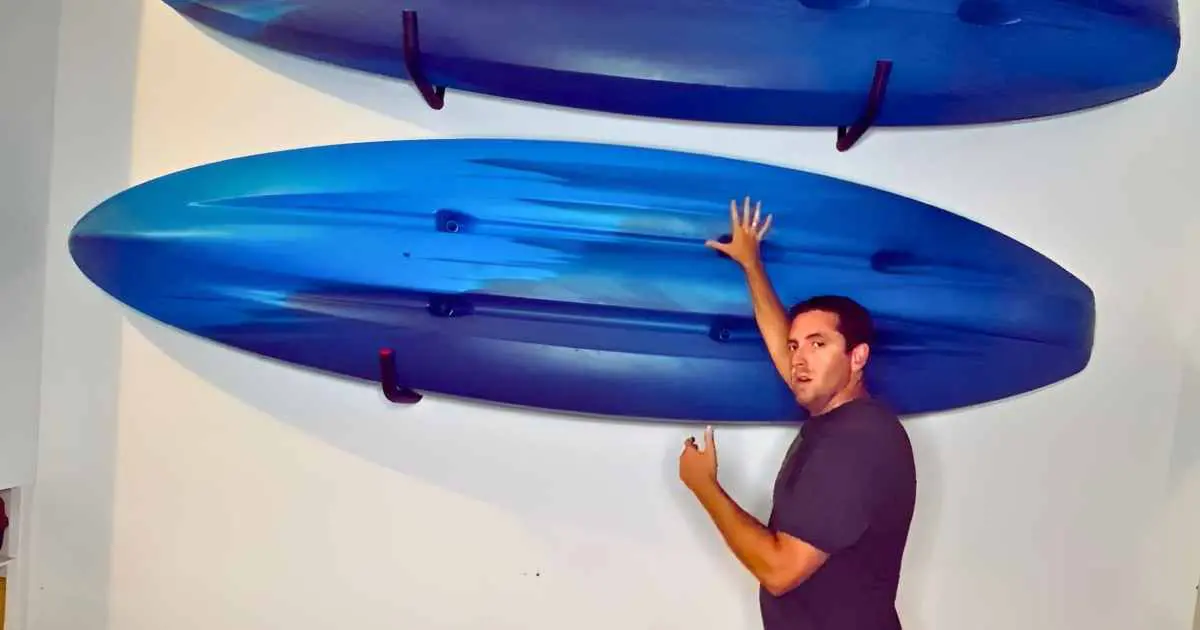

The rack storage method is a game-changer for those who cherish their kayaks and want to keep them in tip-top shape. Whether you’re a seasoned kayaker or just starting out, utilizing storage racks is a tried-and-true approach that offers impressive benefits in terms of stability and organization.
Suitable For
The rack storage method is a solid option if you prefer an organized setup and have more floor space.
Dedicated Racks Vs Diy Solutions
When it comes to rack storage, you have two main choices: dedicated racks or crafting your own. Dedicated racks are designed specifically for kayaks. They come in various sizes and shapes to fit different kayak types, from sit-on-top to sit-inside models.
These racks are built from sturdy materials like steel or aluminum, ensuring they can handle your kayak’s weight over time.
On the flip side, creating your own rack is a great idea if you’re looking for budget-friendly options or enjoy a little DIY adventure. With some creativity and basic tools, you can build a kayak rack using materials like PVC pipes, wooden planks, or metal brackets. This DIY approach lets you customize the rack’s size and design to match your needs perfectly.
Benefits Of Rack Storage
Rack storage boasts several advantages that make it a favorite among kayak owners. Let’s delve into some of these perks:
Stability: The top benefit of a dedicated storage rack is its superb stability. Your kayak is securely in place, preventing wobbles or accidental mishaps. This stability ensures your kayak remains safe and sound throughout its stay on the rack.
Organization: Another fantastic advantage is the improved organization that comes with using a rack. You instantly clear up valuable space in your garage or storage area by elevating your kayak off the floor. This helps keep your surroundings tidy and simplifies accessing your kayak when you’re ready to hit the water.
Different Types Of Racks
The world of kayak racks offers an array of options to suit your needs. Here’s a rundown of some popular types:
Wall Racks: These racks mount on walls and feature padded arms or hooks to hold your kayak securely. Perfect if you’re tight on floor space and want to make the most of your vertical area.
Freestanding Racks: These standalone structures don’t need wall or ceiling attachments. They often have multiple tiers for storing multiple kayaks. Plus, they’re portable, so you can move them around as needed.
Ceiling Hoists: Ceiling hoists use pulleys and ropes to lift your kayak toward the ceiling. These racks are ideal for maximizing vertical storage in high-ceiling spaces, making raising and lowering your kayak a breeze.
Stacking Racks: These racks consist of horizontal bars where you can stack kayaks on top of each other. Great for limited floor space but ample vertical room, they offer compact storage while keeping your kayaks accessible.
Standing Upright Method: Space Maximization And Easy Access
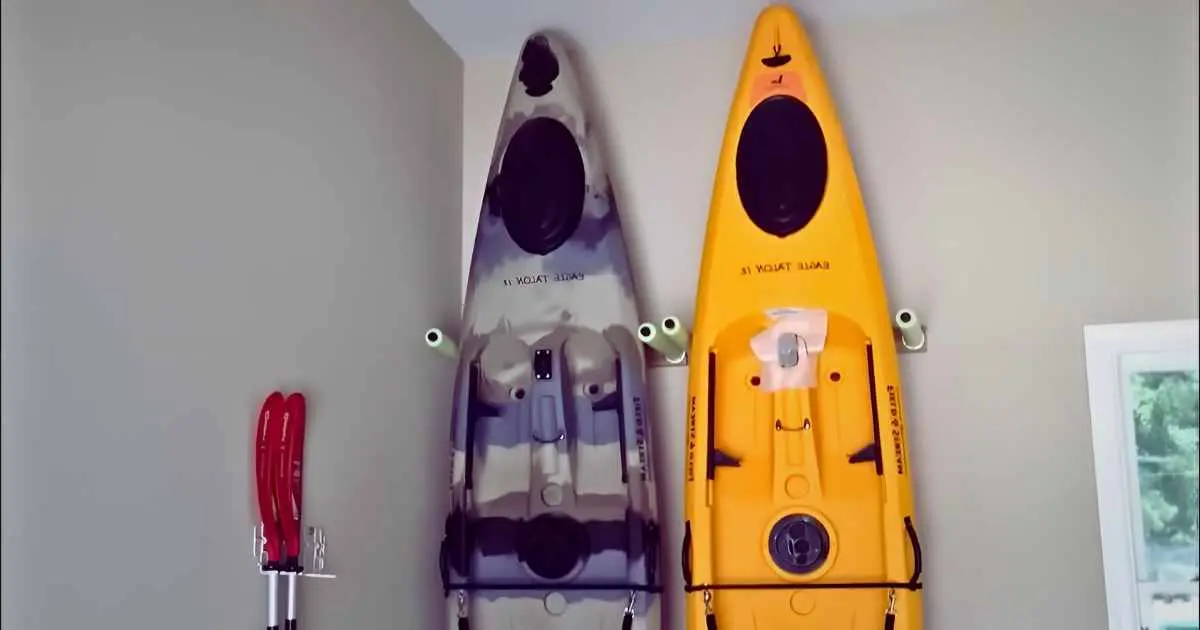

Storing your kayak in an upright position is like unlocking a secret to space-saving and effortless access. By positioning your kayak vertically on its hull or stern end, you save precious floor space and provide secure protection.
Let’s delve into the benefits of this method and discover how to master the art of upright kayak storage.
Suitable For
This method works well if you have an unused corner or a well-ventilated space where you can position your kayak vertically.
Benefits Of Standing Upright Storage: Saving Space And Convenience
One of the most significant perks of upright kayak storage is its minimal space requirement. Compared to other storage methods that might hog a lot of space, standing your kayak up uses the often-neglected vertical space. This becomes incredibly handy if you have limited room or several kayaks to store.
Using foam blocks or cradles designed specifically for kayaks gives your kayak a safe and supportive resting place while it stands upright. These accessories distribute the weight evenly, preventing any potential damage or changes to the shape of your kayak.
Moreover, the convenience factor is off the charts. When you’re all set to hit the water, your kayak is waiting for you—no more wrestling with other things or struggling to move a heavy kayak from a horizontal position. Just grab your gear, and you’re ready to paddle!
Storing Your Kayak Upright: Steps To Success
Here’s your guide to flawlessly storing your kayak in an upright position:
Find a Suitable Spot: Look for a flat surface against a wall where your kayak can safely stand. Ensure there are no obstacles nearby that could accidentally cause harm.
Positioning: Stand the kayak vertically on its hull or stern end, depending on your preference. Choose what feels stable for you.
Use Stands or Supports: If available, utilize specialized stands designed to offer extra support during storage. These stands often come with adjustable straps or bars that secure around the hull, ensuring stability.
Protect Your Kayak: Place foam blocks or cradles on the flat surface to create a soft base for your kayak. This guards the hull against potential scratches or marks while standing upright.
Secure with Straps: If you’re using stands, ensure they’re firmly attached to prevent any unintended tipping. Use straps to secure the kayak to the stands or directly to the wall if necessary.
Avoid Direct Sunlight: Keep your kayak away from direct sunlight, as prolonged exposure can fade colors and harm the materials over time.
A Step-By-Step Guide To Storing A Kayak Indoors
Navigating the waters of indoor kayak storage doesn’t have to be complex. We’ve simplified all the processes into simple actions that help you protect your kayak and make the most of your space.
Step 1: Choosing The Right Storage Method
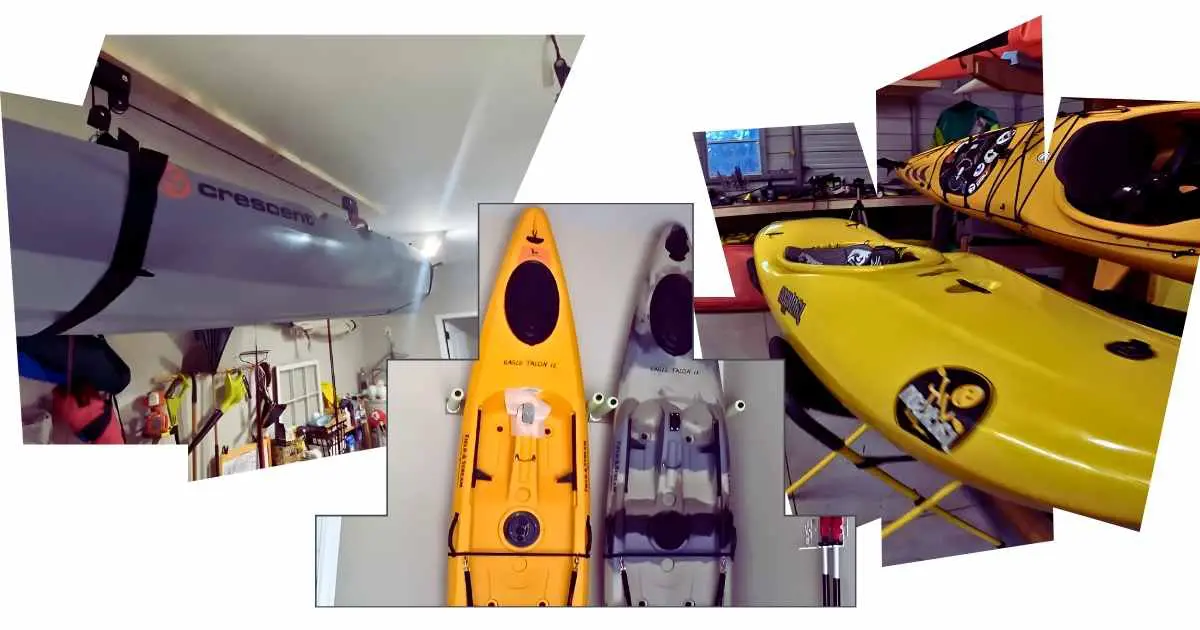

When it comes to keeping your kayak safe, the first thing to do is think about where you’ll store it inside. This step is super important because it helps protect your kayak and makes sure it lasts a long time.
To begin, we’ll talk about picking the best way to store your kayak—whether hanging it up, using a rack, or standing it upright. We’ll also look at how to figure out where in your indoor space your kayak can go.
Let’s explore a few factors to consider When Selecting a Storage Method:
Space: Begin by evaluating your indoor space for kayak storage. Consider the layout and dimensions of your available areas, such as garages, storage rooms, or spare corners.
Protection: Gauge the level of protection each storage option offers. If you’re located in an area with demanding weather conditions or high humidity, prioritize storage solutions that can effectively shield your kayak against these elements.
Accessibility: Reflect on how frequently you envision using your kayak. If you’re an enthusiastic kayaker who frequently embarks on water adventures, opt for a storage method that provides convenient access to your boat whenever you’re ready to set sail.
Security: Consider the security aspect of each storage choice. Depending on your location and storage environment, the level of security against theft or unauthorized access might be of significant importance.
Cost: Keep your budget in mind when considering different storage methods. Different options may come with varying initial investments or ongoing expenses.
Step 2: Choosing The Right Location And Preparing The Storage
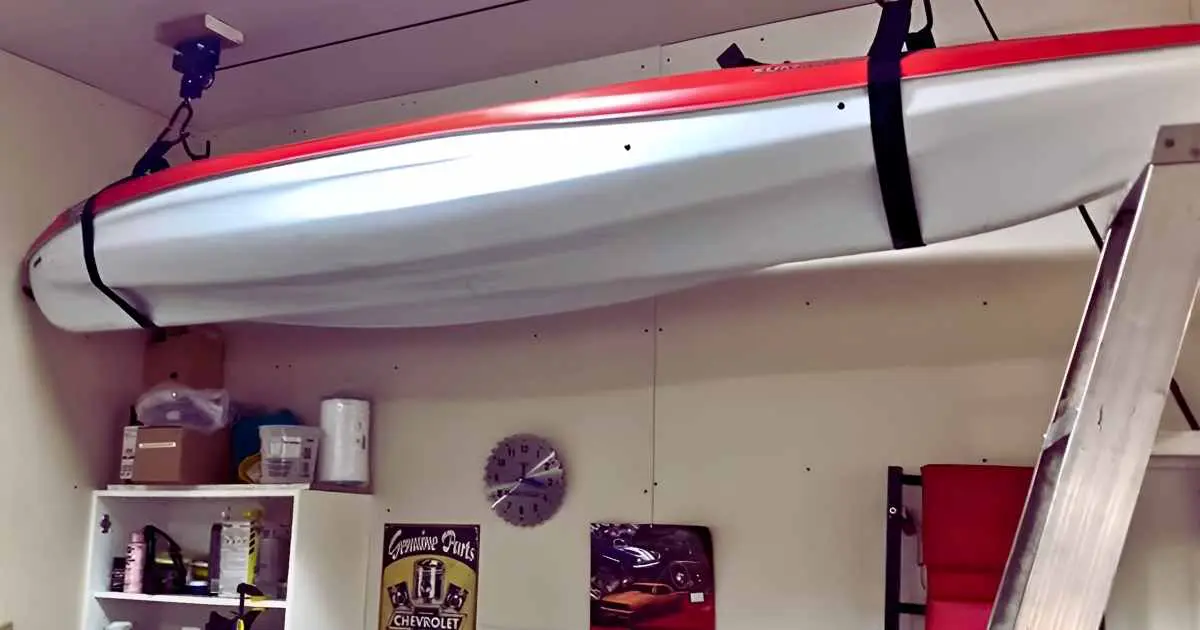

Once you’ve picked the best storage method, the next step is finding the right spot for your kayak and getting everything ready.
In this step, we’ll explore how to choose the perfect location for your kayak and how to prepare the storage area.
Identifying Suitable Locations For Indoor Kayak Storage
Unused Corner: Sometimes, all you need is a tidy corner in a larger room. This can work well if you need more space. Just ensure that the corner is dry and away from any direct sources of potential damage.
Storage Room: Having a dedicated storage room is a fantastic option if you have the space. This allows you to keep your kayak away from the elements and potential disturbances. Make sure the room is organized and free from humidity to maintain your kayak’s condition.
Garage: If you’re lucky to have a garage, it can serve as an excellent place for your kayak. However, it’s important to keep it clean and dry. Moisture can be damaging to your kayak’s materials, so ensure proper ventilation and protection from any potential leaks.
Basement: It can be a smart choice if your basement is spacious and well-ventilated. The underground location might provide a consistent temperature, which is beneficial for your kayak’s preservation. Just make sure the space is free from dampness and clutter.
Preparing The Storage Area
When you’ve chosen the perfect spot for your kayak, getting the storage area ready is essential to keep your watercraft safe and well-maintained. Here’s a detailed look at each step:
Clearing Clutter: Before placing your kayak, ensure the area is clutter-free. Removing any unnecessary items ensures your kayak has enough space and minimizes the risk of accidental damage or scratches.
Setting Up Your Chosen Storage Method: If you’re using a rack, hooks, or stands, now’s the time to set them up properly. Please make sure they’re secure and positioned correctly to prevent any mishaps. The proper setup ensures your kayak stays in place and doesn’t accidentally fall.
Considering Environmental Factors:
- Look around and see if the area is damp or gets sunlight.
- If it’s damp, use things to absorb moisture, like those bags you use in your shoes.
- If there’s too much sun, cover your kayak or move it to a shadier spot to avoid colors fading.
Ensuring Protection: Add a layer of protection before placing your kayak in its designated spot. Soft materials like foam blocks, towels, or padded cushions can be placed underneath the kayak. This creates a barrier against scratches and dings while maintaining the shape of your kayak.
Step 3: Cleaning And Drying Your Kayak Before Storage
Before storing your kayak, it’s a good idea to clean it and ensure it’s nice and dry. This step helps keep your kayak in great shape during storage.
In this step, we’ll go over how to clean and dry your kayak before putting it into storage.
Cleaning Your Kayak


Different kayak materials require specific cleaning agents to avoid causing damage during the cleaning process. Let’s take a closer look at some common kayak materials and the suitable cleaning agents for each:
- Polyethylene (PE): This is one of the most popular kayak materials due to its durability and affordability. For PE kayaks, mild soaps, dishwashing detergents, or specialized cleaners designed for polyethylene are safe options.
- Fiberglass: Fiberglass kayaks offer excellent performance but need extra care during the cleaning. Use mild soaps or specially formulated fiberglass cleaners that won’t scratch or dull the surface.
- Composite Materials (Kevlar/Carbon Fiber): Composite kayaks are lightweight and strong but require gentle handling. Mild detergents or cleaners specifically made for composite materials should be used.
- Inflatable Kayaks: Inflatable kayaks have unique maintenance requirements compared to hard-shell kayaks. Follow the manufacturer’s instructions regarding suitable cleaning agents and methods, as they may vary depending on the specific inflatable material used.
Drying Your Kayak
Air Dry: Let your kayak air dry in a shaded spot. Avoid direct sunlight, as it can cause fading and material damage.
Turn It Over: Turn your kayak upside down to make sure all the water drains out. This helps prevent moisture buildup.
Towel Dry: You can use a clean towel to gently dry any remaining water droplets on your kayak’s surface.
Step 4: Protecting Your Kayak From The Elements: UV, etc.
Keeping your kayak safe from the elements is crucial to maintaining its quality over time. This step focuses on shielding your kayak from potential harm, such as UV rays and other environmental factors.
Let’s explore how to protect your kayak before storing it indoors.
Avoid Direct Sunlight: Position your kayak away from direct sunlight if possible. Prolonged exposure to UV rays can fade colors and weaken materials over time.
Use Covers: Consider using a cover if your storage area is partially shielded from light. A simple tarp or specialized kayak cover can provide an extra layer of defense against sunlight and dust.
Check for Leaks: Regularly inspect your storage area for leaks. Even indoors, leaks can happen, and they can lead to moisture buildup and potential damage to your kayak.
Ventilation Matters: Ensure that your storage area is well-ventilated. Good airflow helps prevent trapped moisture, which can lead to mold and mildew growth.
Step 5: Locking Up Your Kayak Properly
Securing your kayak is the final step to ensure its safety during storage. This step focuses on choosing the right security measures and attaching your kayak properly to storage structures.
Let’s dive into how to lock up your kayak effectively before leaving it in indoor storage.
Choosing The Right Security Measures
Sturdy Materials: When it comes to locks or cables, opt for those made from strong materials like hardened steel or braided steel cables. These are tough to cut through and provide better protection than flimsy options.
Combination Locks: Consider using a combination lock. They’re convenient since you don’t need to carry keys, but make sure the combination is easy for you to remember yet hard for others to guess.
Weather-Resistant Options: Since kayaks might be stored outdoors, choose locks that can handle different weather conditions without rusting or deteriorating over time.
Check Customer Reviews: Read customer reviews online before purchasing any locking mechanism. This helps you gauge the effectiveness and durability of various products.
Proper Attachment To Storage Structures
Check the Cockpit: Before attaching your kayak, inspect the cockpit for any damage that might affect its stability during storage. Fix any cracks or loose fittings.
Use the Right Straps: Secure your kayak using straps or bungee cords specifically designed for this purpose. Make sure they’re tight enough to keep the kayak in place without causing damage.
Follow Manufacturer’s Instructions: Different kayaks might have specific guidelines for attaching to storage structures. Always refer to the manufacturer’s instructions to ensure you’re using the right method and hardware.
Consider Extra Support: Add extra support with more straps or ropes in areas prone to strong winds. This enhances stability and prevents your kayak from moving around.
Comparing Different Kayak Storage Methods For Indoors
When it comes to choosing the ideal method for storing your kayak indoors, let’s delve into a comprehensive comparison of the three options: hanging, rack storage, and standing upright. Each method has distinct advantages and suitability for different indoor spaces.
Let’s have a look at the comparison table that evaluates the Hanging, Rack, and Standing Upright kayak storage methods based on various factors:
| Criteria | Hanging Method | Rack Storage Method | Standing Method |
|---|---|---|---|
| Space Requirements | Wall/ceiling space needed | Sturdy racks support up to 150 lbs weight | Small corner or vertical space usage |
| Durability | Durable materials withstand hanging weight | Support up to 150 lbs weight | Stable positioning prevents movement |
| Ease of Use | Easy access, quick retrieval | Easy to slide kayak into rack slots | Straightforward placement and access |
| Installation | Attach brackets/hooks to wall/ceiling | Rack installation required | Simple positioning, no complex setup |
So Which Method Is Best For Storing Your Kayak?
When it comes to selecting the optimal method for storing your kayak indoors, it largely depends on your available space, storage preferences, and how frequently you use your kayak.
Let’s delve into the advantages of each method to help you make an informed decision:
Choose The Hanging Method If
You have limited floor space and available wall or ceiling space. This method maximizes floor space, offers easy access, and is perfect for frequent kayak users.
Advantages:
- Efficient utilization of vertical space, perfect for limited floor areas.
- Easy access and quick retrieval for frequent kayak use.
- Maximizes space for other activities or storage needs.
Choose Rack Storage Method If
You have more floor space and seek an organized setup. This method provides stability, preserves the kayak shape, and offers better organization.
Advantages:
- It provides stable support that preserves the kayak’s shape over time.
- Enhanced organization with designated slots for multiple kayaks.
- Utilizes floor space efficiently while maintaining a clutter-free environment.
Choose the Standing Upright Method If
You have small corners to spare or want to maximize vertical storage. This method saves floor space, suits well-ventilated areas, and is ideal for those with limited room.
Advantages:
- Maximizes vertical space, making it ideal for small corners or tight spaces.
- It allows for proper ventilation and keeps the kayak off the floor.
- Perfect for maintaining an organized and unobtrusive storage area.
7 Mistakes To Avoid When Storing Your Kayak
Proper kayak storage is essential to keep your watercraft in top condition and ready for your next adventure. Avoiding common mistakes can prolong its lifespan and ensure a smooth paddling experience.
Here are seven crucial mistakes to steer clear of:
Storing On Hard Surfaces
Placing your kayak directly on hard surfaces like concrete or asphalt can lead to hull damage and warping. Use foam blocks or cradles to provide a protective cushion.
Over-Tightening Straps
While securing your kayak is necessary, overtightening straps can deform the hull over time. Ensure a snug fit without putting excessive pressure on the kayak’s structure.
Proximity To Heat Sources
Avoid storing your kayak near heat sources like radiators or direct sunlight. Prolonged exposure to heat can weaken the material and affect its shape.
Neglecting Cleaning
Storing a dirty and wet kayak can lead to mold and odors. Clean and thoroughly dry your kayak before storage to prevent moisture-related issues.
Stacking Heavy Items
Placing heavy objects on top of your kayak can cause pressure points and deformation. Keep the storage area clear and free from heavy loads.
Ignoring Pests
Rodents and pests can cause damage to your kayak by chewing on straps and materials. Use deterrents or covers to protect your kayak from unwanted visitors.
Environmental Neglect
Storing your kayak in environments with extreme temperatures, humidity, or direct sunlight can lead to material degradation. Choose a storage location that safeguards your kayak from environmental factors.
Learn More
How Often Should I Clean My Stored Kayak?
It is recommended to clean your stored kayak at least once every few months to prevent dirt buildup and maintain its overall condition.
Is Using A Cover When Storing My Kayak Indoors Necessary?
While not essential when storing indoors, using a cover provides an extra layer of protection against dust and potential scratches.
Can I Store My Kayak Vertically Without Any Support?
It is only advisable to store a kayak vertically with proper support, as it can cause strain on the hull structure and potentially lead to damage.
How Can I Prevent Pests From Nesting In My Stored Kayak?
To deter pests, consider using natural repellents like mothballs or cedar chips around the storage area. Regularly inspect your kayak for signs of infestation and take appropriate measures if needed.
Final Words
In wrapping up, learning how to store your kayak indoors is key to keeping it safe and sound for the long haul. The three indoor storage methods we’ve explored—hanging, rack storage, and standing upright—give you options to fit different spaces and needs.
Each method brings its benefits, like saving floor space, keeping your kayak’s shape, and using room vertically. By measuring your indoor space, frequency of use, and what you like in terms of organization, you can pick the one best suited for your indoor.

